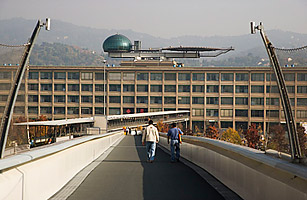
Lingotto, now a space for shops, hotels, a glass-orb conference center and a helipad
(2 of 2)
Torino's experience suggests that development can't necessarily be left to its own devices, especially in the face of historic forces like deindustrialization. Industry can be guided, even given a boost. Public agencies and philanthropies can provide small and medium companies with some of the services that would be handled by the back office at a company like Fiat or General Motors: funding R&D, promoting products, attracting talent and financing start-ups. In addition to hosting the 2006 Winter Olympics, Torino has revamped its public transportation, redeveloped industrial sites and invested heavily in culture and tourism. "The private sector is not going to invest only because there's open space," says Sergio Chiamparino, Torino's mayor. "Our principal lever is the things our territory has to offer."
One of those things is Torino's university, the Politecnico di Torino, which the city has leveraged into industrial advantage. An extension of the campus hosts the I3P incubator, where start-ups can get a three-year jump start and contacts with consultants and funders, which could lead to no-collateral loans from local banks. Nearby, workers are finishing a $33 million facility where General Motors designs and tests diesel engines. GM established the branch in 2005 after breaking off a joint venture with Fiat, electing to remain in Torino in no small part for the skills of the Politecnico's graduates, who make up more than half the project's 420 engineers. "They're almost plug and play," says Romualdo Ruotolo, a manager at GM. "They have a lot of knowledge when it comes to diesel engines."
The city's example has encouraged the likes of Cleveland, where a group of philanthropists has teamed up with local politicians to boost the region's economy. Once a powerhouse of heavy industry — steel, rubber, automobiles — Cleveland has struggled for decades to find its footing. Recently, however, the city and the surrounding area have established agencies like those in Torino to help young companies get off the ground, assist midsize businesses with finding new markets and guide the city's old manufacturing base into faster-growing sectors such as medical supplies, flexible electronics, clean energy and next-generation polymers. "The question is, What do you do if Bill Gates doesn't settle down in your town?" says Brad Whitehead, president of the Fund for Our Economic Future, a partnership of more than 100 regional philanthropies. "We're trying to put ourselves in the way of luck."
Cleveland and its region are now home to 19 venture-capital firms — up from two in 2000 — and are focused on working to help existing firms find their places in the new economy. GrafTech, a company that once provided carbon and graphite products exclusively for the steel industry, now makes heat sinks for electronics. And Lumitex, a maker of backlighting systems for LCDs and dashboards, has expanded its customer base from car companies to hospitals, providing lighting for surgery. "We need to build on our region's existing strength in old-line manufacturing and connect them to these high-growth sectors," says Daniel Berry, president of MAGNET, a government-funded organization that advises the region's manufacturers. "It would take northeast Ohio a very long time to build a new economy using only entrepreneurial start-ups."
If Cleveland has one advantage, it's that its belt has already been tightened. Since April 2009, Cleveland's unemployment rate lagged the national average. In the first half of this year, it was a leader in private-sector job growth — signs, say the city's leaders, that by following in the footsteps of Torino, the metropolis might have finally found the way out of its slump. "We have to do this," says Whitehead. "We have to achieve a transformation. You see and hear a story like Turin's, and you say, 'Well, maybe it's a tall mountain, but it's a mountain that can be scaled.'"